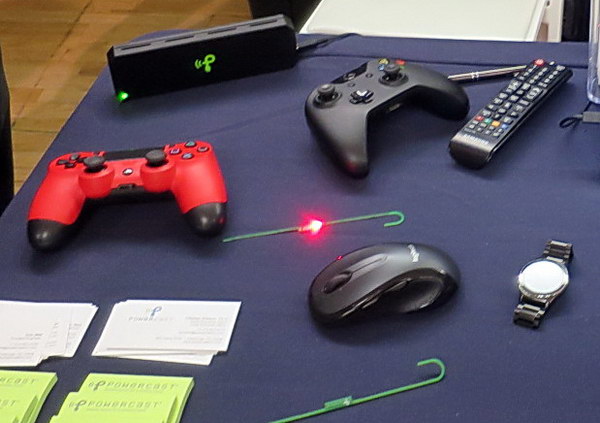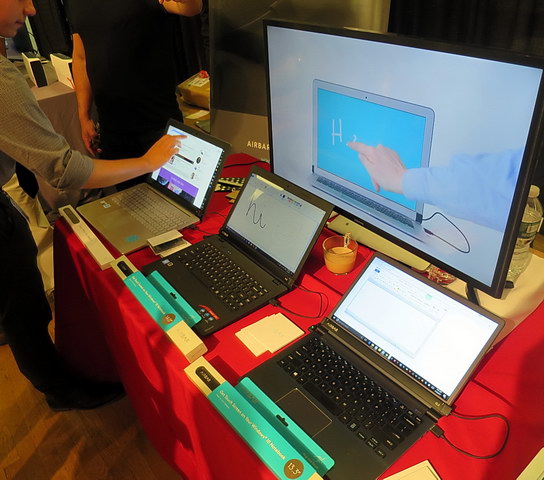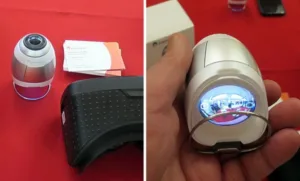Pepcom events are often mostly full of silly apps and hardware gadgets targeted at consumers. Their June 15th event in New York was no exception, but I found three interesting technologies that should be of interest to Display Daily readers: wireless charging for the Internet of Things (IoT), a nice 360° camera targeted at live streaming of video and an add-on to provide touch screen capability to laptop computers.
Eric Biel, Principal Engineer at Powercast, told me his company has been providing wireless charging and power harvesting chipsets for 14 years for professional applications and is just now moving into consumer markets, especially the Internet of Things (IoT) market. His company uses a true broadcast power approach and does not use phased arrays or other approaches to focus the power on the unit to be powered. This results in very low power transfer efficiency – a 3W transmitter can be expected to deliver microwatts to low milliwatts of power to a device. Biel claims this is not a major problem and said a 3W transmitter running 24/7 for a year will consume about $1.00 of electricity. He said this is a small price to pay for the convenience of wireless charging. One advantage of broadcast power is there is no limit to the number of devices that can be powered simultaneously since every device in the rather broad beam harvests its share of power.
At Pepcom, the company was showing a variety of devices they had modified for wireless power by installing one of their power harvesting chips and a receiving antenna, as shown in the photo. The size of the antenna needed limits the size of the unit that can use their system. In the photo, the cane shaped object represents a ½ wave antenna for the wavelength they are using and has a LED mounted in the center and powered by a Powercast chip in turn powered directly by the antenna – no battery or other storage. You could pick the device up and move it around. The brightness of the LED gave you a rough idea of the amount of power the device was harvesting at any given location.
The company is targeting its chips at OEM manufacturers and is not targeting consumers directly. Powercast power harvesting ICs are available now from Arrow Electronics, Future Electronics and Mouser Electronics.
 Multiple devices being powered simultaneously by the Powercast transmitter at the upper left. (Photo credit: M. Brennesholtz)
Multiple devices being powered simultaneously by the Powercast transmitter at the upper left. (Photo credit: M. Brennesholtz)
Tamaggo was showing a camera with 360° horizontal field of view (FOV) and 220° vertical FOV. The camera is intended to sit on a table top or other surface and stream video. It will image the complete 360° horizon and objects up to 20° below the horizon, plus everything including the sky above the camera. It does not image the floor or tabletop below the camera. This allows you to capture a whole scene in one click without need for framing, rotating, stitching or stabilizing. The company says, “Enjoy the moment, forget the camera.”
The camera includes what they call a professional quality fish-eye lens and a Sony 12Mpixel sensor. It is said to be able to produce 4K still images or live-stream HD video. They were not demonstrating live streaming at Pepcom, however. According to Frederique Huillet, COO, this was because of the very busy Wi-Fi environment at Pepcom. Live streaming to a smartphone could be shown in either of two formats. First, the smartphone could show a single image and moving the phone around would show different portions of the main image. Second, the smartphone could show two images for use in a smartphone-based HMD.
The camera also includes a 1.5” touch screen display for control, which would normally not be visible since it is in the base and the unit sits on this base for normal operation. The camera includes IEEE 802.11 a/b/g/n (Wi-Fi), Bluetooth 4.0 and MicroUSB connectivity. There is a MicroSD card slot and a 1500mAh battery, said to be good for two hours of video.
The camera can be pre-ordered now on Kickstarter for $299, with expected deliveries stating in July. Huillet said the MSRP would eventually be $399.
Left: Tamaggo camera sitting on its base. Right: 1.5” touchscreen display built into the base of the Tamaggo camera. (Photo credit: M. Brennesholtz)
Neonode Inc. was showing their AirBar touch screen system at Pepcom (NeoNode Enables Notebooks with Touch). Previously, they had shown the system for 13” MacBook Air computers at CES but at Pepcom, they were also showing versions for 13.3”, 14” and 15.6” Windows 10 laptops with an aspect ratio of 16:9.
The Airbar system is a long, narrow device that fits into the hinge of an open laptop and plugs into a USB port which both inputs the touch data to the computer and powers the bar. It must be removed before the laptop can be folded flat. Optical sensing is Neonode’s main business and the AirBar unit contains an IR touch screen detector. The rep at Pepcom said the external AirBar had several advantages over a built-in touchscreen. One major advantage is touchscreens tend to be more reflective than ordinary screens, increasing glare. The high reflectivity also reduces output from the screen, requiring increased power from the laptop battery to provide the same screen brightness. AirBar itself consumes about 5mW in standby and 50mW when active.
AirBar is available now for Dell Laptops and the MacBook Air at prices ranging from $69 – $99, depending on the Operating System and size. –Matthew Brennesholtz
 Airbar shown on three different Windows 10 laptops at Pepcom. (Photo Credit: M. Brennesholtz)
Airbar shown on three different Windows 10 laptops at Pepcom. (Photo Credit: M. Brennesholtz)

